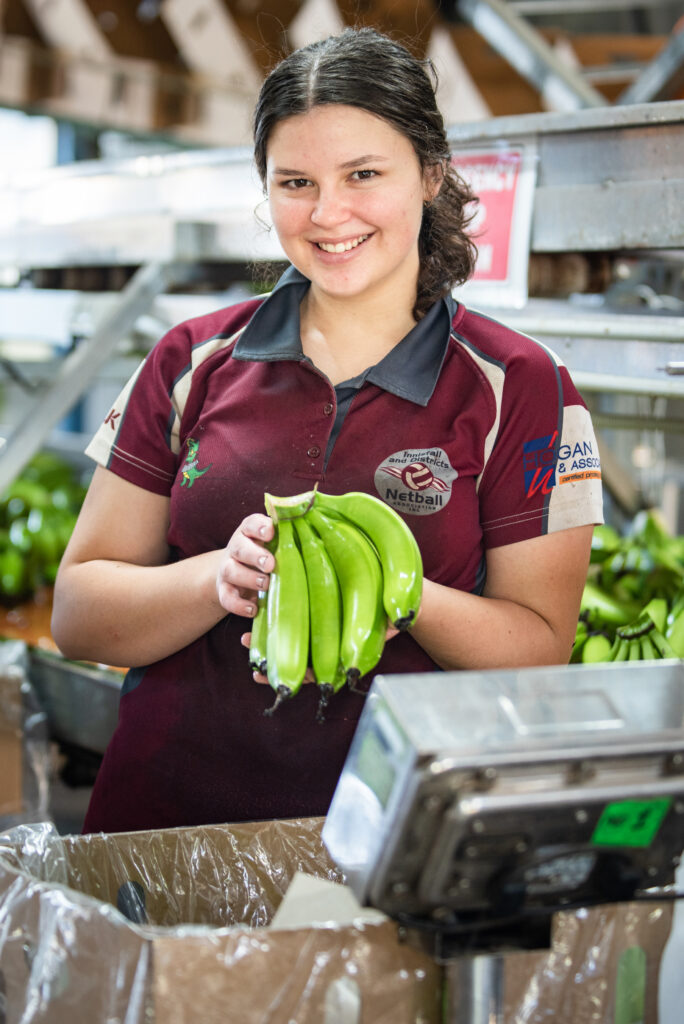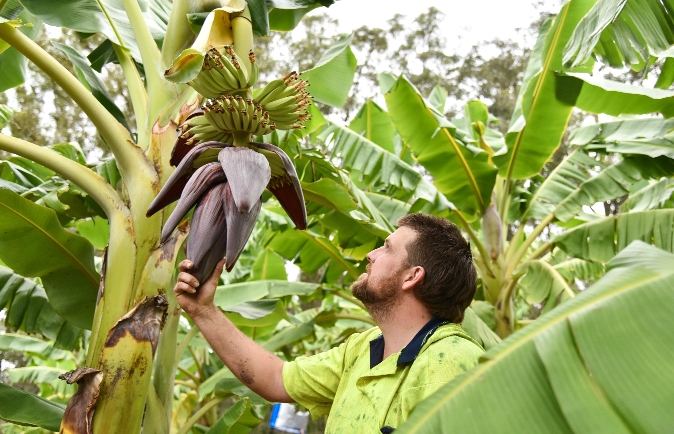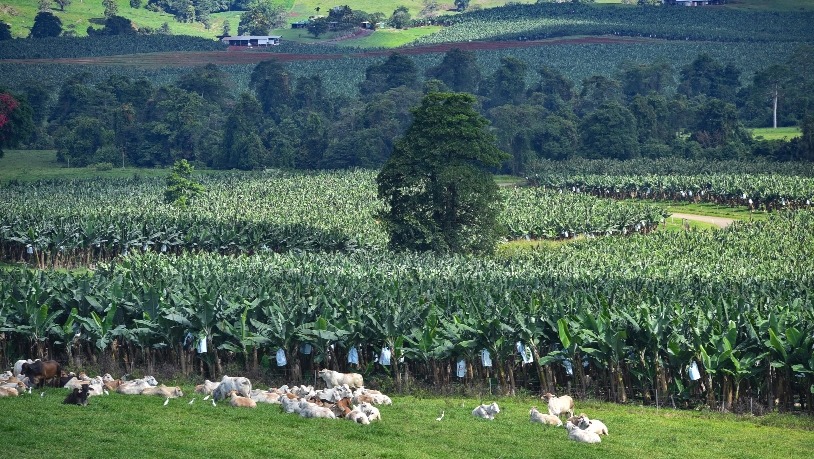
OUR INDUSTRY
More than five million bananas are eaten every day in Australia. Find out more about the industry behind the much-loved fruit.
KEY FACTS
CONSUMERS
More than 90 per cent of Australian households bought bananas in the financial year ending June 2024, with per capita consumption sitting at 13.53kg.
Bananas also represented the highest percentage of fresh produce dollar sales (7.7%) in the 2022 Produce Plus – Nielsen IQ Top 20.
PRODUCTION
94 per cent of Australia’s banana production happens in Far North Queensland. The major growing regions are the Cassowary Coast (Tully, Innisfail and Kennedy), the Atherton Tablelands, and Lakeland, north of Cairns.
The Cavendish banana represents about 97% of production. Lady Fingers account for 3% with other varieties including Red Dacca, Goldfinger, Sucrier, Ducasse and Plantains sitting at less than 1%.
Australian production was sitting at approximately 369,000 tonnes of fresh bananas in 2023/24 (levy-based figures). Production was valued at $697.8m.

Approx 540 farms
Majority family-run
100% Aussie grown
$698m value
+90% homes consume

DID YOU KNOW
Australians eat 5,000,000 bananas every day (enough to have a banana road from Melbourne to Sydney).
- Bananas are always bent due to a phenomenon known as negative geotropism. Once developed, instead of growing towards the ground, bananas turn towards the Sun. The fruit continues growing against gravity, giving the banana its familiar curved shape.
- Despite their firm texture, bananas are composed of 75% water. That’s more than the human body which is 60% water.

ECONOMIC CONTRIBUTION
- Based on 2023/24 compulsory levy figures, the national industry sold 368,000 tonnes of bananas.
Production was valued valued at $697.8m and fresh supply was $845.6m.
In November 2018, Pinnacle Agribusiness released the Banana Enterprise Performance Comparison, funded by Hort Innovation. It noted the farm gate value from the 2016/17 production of 414,000 tonnes was $679m. This delivered a $1.3 billion contribution to the economy.
EMPLOYMENT
The Banana Enterprise Performance Comparison showed the industry supported more than 18,000 full-time and part-time jobs (including supply chain) in Australia.
The banana industry is the major economic driver and employer in Tully, Innisfail, Mareeba, Kennedy, Lakeland and Carnarvon.
STATE COMPARISON
The following table shows significant increases in Queensland as the dominant producing State, over the last two decades.

*Cyclone Olwyn destroyed Carnarvon’s production and the Freckle eradication program meant all NT banana plants in the Top End were destroyed.

GROWING REGIONS
In Australia, bananas are grown in both tropical and subtropical regions. This ensures the industry is diverse in terms of:
- the geographical location of banana farms
- farming practices
- the size and type of farms that grow bananas
- banana varieties and
- the flavour of the bananas grown
The tropical banana-growing regions of Queensland produce most of Australia’s bananas. These regions are in north Queensland – mainly in the Tully and Innisfail areas. Other tropical production areas are in the Northern Territory and the northern parts of Western Australia, at Kununurra.
Subtropical bananas are grown in northern New South Wales and southern Queensland – from south of Coffs Harbour in New South Wales north to Bundaberg in Queensland – and in Carnarvon in Western Australia.
All fresh bananas available in Australia are grown here – there are no imports due to the plant pest and disease threats these would pose to our local farms.
In north Queensland, Tully is the major banana-growing region – not only for the region but for all of Australia. Other major growing areas in north Queensland are Innisfail, Silkwood and Mourilyan, the Atherton Tablelands and Lakeland.
The first banana plantations were started by the Chinese migrants working on the goldfields. In the Tully area, bananas were shipped to market via the Tully River.
The trade in north Queensland bananas stopped during World War I when there were restrictions on local shipping and outbreaks of plant disease.
The banana industry re-established at the end of World War II in 1945. Bananas were cut and packed in 40kg wooden boxes and transported to market by rail up until the 1960s when road transport was introduced. Today bananas are packed in cardboard cartons and transported by both road and rail in refrigerated containers.
The subtropical banana growing districts in southeast Queensland provide fruit for local markets and shops, with some also going to the Brisbane Markets.
In southeast Queensland, the main banana growing areas are at Wamuran, which is in the Caboolture region north of Brisbane, on the Sunshine Coast and in Bundaberg.
The Territory is Australia’s northern most banana production area. However, the soil-borne fungal disease Panama TR4 has substancially reduced banana production there when it was identified in the 1990s.
Banana production figures from the Northern Territory Government’s Department of Primary Industry and Fisheries show banana production had declined from about 7,000 tonnes in 2000 to about 2,000 tonnes in 2007.
Banana freckle was detected in the Top End of the Northern Territory (NT) in 2013, with eradication officially completed in 2019. It was detected again in 2022.
While there are still some banana growers in the region, currrently the NT and SEQ combined represent less than 1% of production.
The Territory is also home to some disease-resistance trials.
Northern New South Wales was the home of the first major commercial banana platations in Australia and is still an important growing region.
NSW was home to most of Australia’s bananas through the 1900s, up until the late 1900s when north Queensland began to increase production.
In 1891, Herman Reich started plantations of Coffs Harbour and surrounding areas. Other pioneering growers included Chinese and Italian farmers in the far north and Indian Sikh communities continue to be actively involved in growing bananas across Australia.
Currently, the main growing regions are around Murwillumbah and the Tweed, new the Queensland border; west across to Lismore and south to Ballina. Further south, there are growing regions from Woolgoolga, north of Coffs Harbour, down to Stuart’s Point which is south of Nambucca Heads.
Fruit is sent to the major markets of Sydney and Melbourne and is also enjoyed locally.
NSW accounts for about 4% of national production.
Carnarvon is Western Australia’s largest banana growing area, with some fruit also grown in Kununurra. Carnavon bananas are typically smaller and sweeter than bananas from eastern Australia. A number of growers in the Carnavon region are now part of the Sweeter Banana Co-operative, supplying WA markets.
